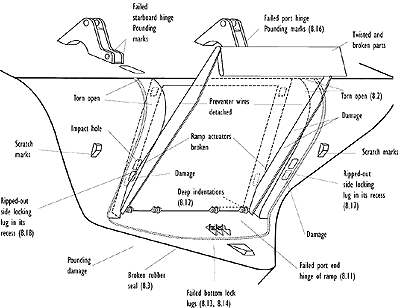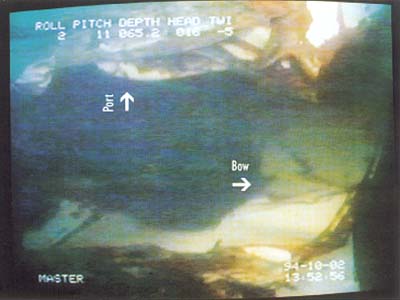 |
 |
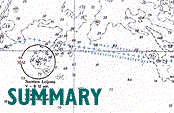 |
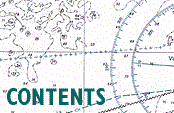 |
CHAPTER 8 OBSERVATIONS AFTER THE ACCIDENT |
||
8.1 Locating the wreck |
||
|
The locating of the wreck of the ESTONIA started on 29 September 1994, the day after the accident. The work was performed by the hydrographic survey vessel SUUNTA operated by the Finnish Maritime Administration. A side-scan sonar and a multibeam echo sounding system were used in the search.
|
||
8.2 ROV inspections |
||
|
At its first meeting on 29 September 1994 the Commission decided that the wreck should be examined with a submarine Remotely Operated Vehicle (ROV) to ascertain her general condition and whether the bow visor had become detached. This work was performed by the Archipelago Sea Coast Guard Section of the Finnish Frontier Guard. The oil pollution control vessel HALLI of the Ministry for the Environment of Finland served as the operational vessel.
|
||
8.3 Recovery of the visor |
||
|
The Commission decided at its meeting in Turku on 3 - 4 October that a search was to be made for the bow visor. This was done by the TURSAS, equipped with a side-scan sonar and a low-frequency echosounder. The Estonian Coast Guard vessel EVA-200, equipped with a side-scan sonar, took part in the search.
|
||
8.4 Diving investigation |
||
|
The Swedish Government ordered a diving survey of the wreck to establish the condition of the interior of the vessel and the feasibility of lifting the entire wreck or recovering individual victims. A commercial deep-sea diving contractor was commissioned by the Swedish Maritime Administration for this purpose. The diving contractor was also commissioned to perform - for the Commission - a survey of the navigation bridge and the vessel's bow area. The diving survey was supplemented by ROV inspection of certain areas. The survey was carried out on 2 - 5 December 1994.
|
||
8.5 Damage to the wreck |
||
|
Damage to the visor and ramp attachment devices is covered briefly here for completeness of the description and is covered in further detail in 8.6.
No external damage other than that in the visor and forward ramp area was observed on the wreck. Window panels were, however, pushed out in several places on the accommodation decks and doors in the aft bulkhead on decks 5 and 7 were missing. A door in the front bulkhead on deck 5 was open.
Diving and ROV inspections of the bow area of the wreck revealed certain damage to the installations in the bow area which are summarised in Figure 8.1.
Figure 8.1 Summary of damage in the bow area with reference to other figures.
The deck hinge fittings on deck were undamaged except for pounding marks on their forward faces. The visor parking support was undamaged.
Figure 8.2 Damaged deck and front bulkhead in front of the opening for the visor operating actuator on the port side.
The side locking lugs remained in their recesses, engaged on the locking bolts.
Figure 8.3 Broken visor rubber seal on the starboard side of the forepeak deck.
Pounding damage was recorded to the shell plating edges around the forepeak deck and to the ice-breaking stem on the bulbous bow. Various scratch marks were noted on the bulbous bow. Continues... |
||
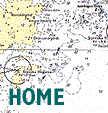 |
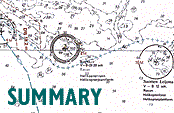 |
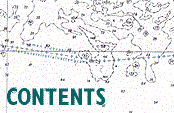 |
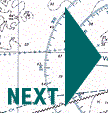 |
